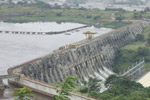One of the world’s most controversial mega-dam projects met its likely end this week when Chile’s Committee of Ministers voted to cancel the permits for the HidroAysén project. Costing around $8 billion and expected to produce about 2.75 gigawatts, the HidroAysén project involved building five large dams on two wild rivers in Chile’s famously-unspoiled Patagonia region. Yet critics of the proposal said it threatened both the environment and local communities.
“Patagonia’s rugged and varied wilderness is truly an environmental treasure. These giant dams would have put at risk the wilderness, traditional culture, and local tourism economy of this remarkable region,” said Amanda Maxwell, the Latin America Project Director at the Natural Resources Defense Council (NRDC).
From the beginning the project was opposed by a large assortment of local and international groups in a coalition known as the Patagonia Defense Council (PDC). However, the project was approved by the government in 2011 and then survived a 3-2 decision in 2012 by Chile’s Supreme Court. But the decision to cancel the permits this week, by Chile’s highest administrative authority, was unanimous.

The Baker River in Chile’s Patagonia region. This is one of two rivers which would have been dammed by the HidroAysén project. Photo by: Jorge Morales F.
“The government’s definitive rejection of the HidroAysén project is not only the greatest triumph of the environmental movement in Chile, but marks a turning point, where an empowered public demands to be heard and to participate in the decisions that affect their environment and lives,” said Patricio Rodrigo, Executive Secretary of the PDC.
Built on the Baker and Pascua Rivers, the dams would have flooded 5,700 hectares of land and required 1,600 kilometers of power lines. It would have forced several families to move and destroyed habitat for the huemel (Hippocamelus bisulcus), a small deer that appears on Chile’s Coat of Arms. Categorized as Endangered by the IUCN Red List, the deer’s population dropped by a stunning 99 percent. However, the species is now seeing a slight reemergence with a population of about 2,500 animals, according to a paper last year.
Critics of the dams contended that most of the energy would not go to the Chilean people, but to the mining industry. In addition, they said there were alternatives beyond hydropower and conventional fossil fuels.
“The country’s future energy needs are better served by building truly sustainable energy: renewables and energy efficiency,” noted Maxwell.
However, some opposition leaders to the current government, under President Michelle Bachelet, have criticized the decision and warned that it will cause energy prices to rise.
The companies behind the dams—Colbún, a Chilean company, and Endesa Chile, a local subsidiary of the Italian energy company, Endesa—have 30 days to appeal the decision.
Related articles
Dams be damned: study finds large dams are too expensive

(05/19/2014) Hydroelectric power, supplied mostly from dams, provides approximately 20 percent of the world’s electricity, an amount of energy equivalent to 3.6 billion barrels of oil. However, a recent study by researchers at Oxford University has found that large dams cost so much money and take so long to build that they may not be economically viable.
Controversial Amazon dams may have exacerbated biblical flooding

(03/16/2014) Environmentalists and scientists raised howls of protest when the Santo Antônio and Jirau Dams were proposed for the Western Amazon in Brazil, claiming among other issues that the dams would raise water levels on the Madeira River, potentially leading to catastrophic flooding. It turns out they may have been right: last week a federal Brazilian court ordered a new environmental impact study on the dams given suspicion that they have worsened recent flooding in Brazil and across the border in Bolivia.
Africa to build world’s largest dam, but who will benefit?

(12/17/2013) The Congo River traverses the continent of Africa, ending its journey in the Democratic Republic of Congo (DRC) where it spills 1.5 million cubic feet per second into the Atlantic Ocean. Now, plans are underway to harness this tremendous force of water in what promises to be the world’s largest hydropower scheme, The Grand Inga.
Gold mine near controversial Belo Monte dam suspended
(11/22/2013) A gold mining project proposed near the Belo Monte dam site in the Amazon rainforest has been suspended by a Brazilian court, reports Reuters.
Murum dam blockaders may be suffering human rights violations warns NGOs
(11/12/2013) A coalition of nearly 30 organizations has sent a letter to top authorities in Sarawak and Malaysia warning them of possible human right violations against a group of indigenous Penan who are blocking roads to the construction site for Murum Dam. Over 100 indigenous people have been blocking a road for over a month as they demand more compensation and land after being forced to move from their traditional lands to make way for the 900 megawatt dam.
8 tribesmen arrested in Borneo dam protest
(11/07/2013) Malaysian authorities arrested eight indigenous protestors on Thursday in a crackdown on a long-running demonstration against a dam the tribesmen say will flood their homeland in Malaysian Borneo.
Indigenous groups expel workers, blockade another dam in Sarawak

(11/05/2013) Hundreds of tribal people in Sarawak have started blockading a second big hydroelectric dam project being built by a government, which critics accuse of nepotism and corruption. Late last month around 200 native Kenyah, Kayan and Penan people chased away workers and set up a blockade on a road leading to the site of the proposed 1200 megawatt Baram dam.